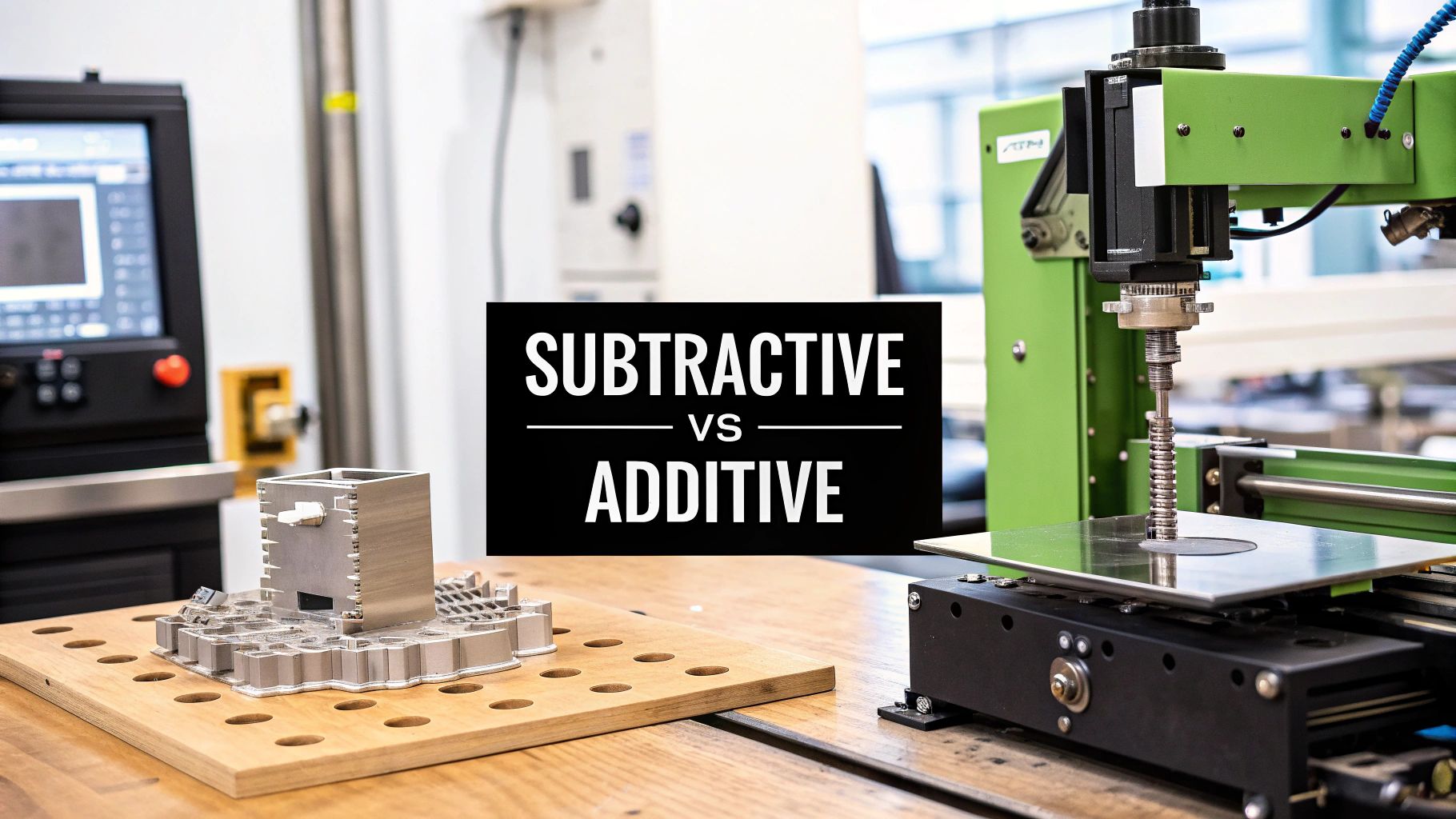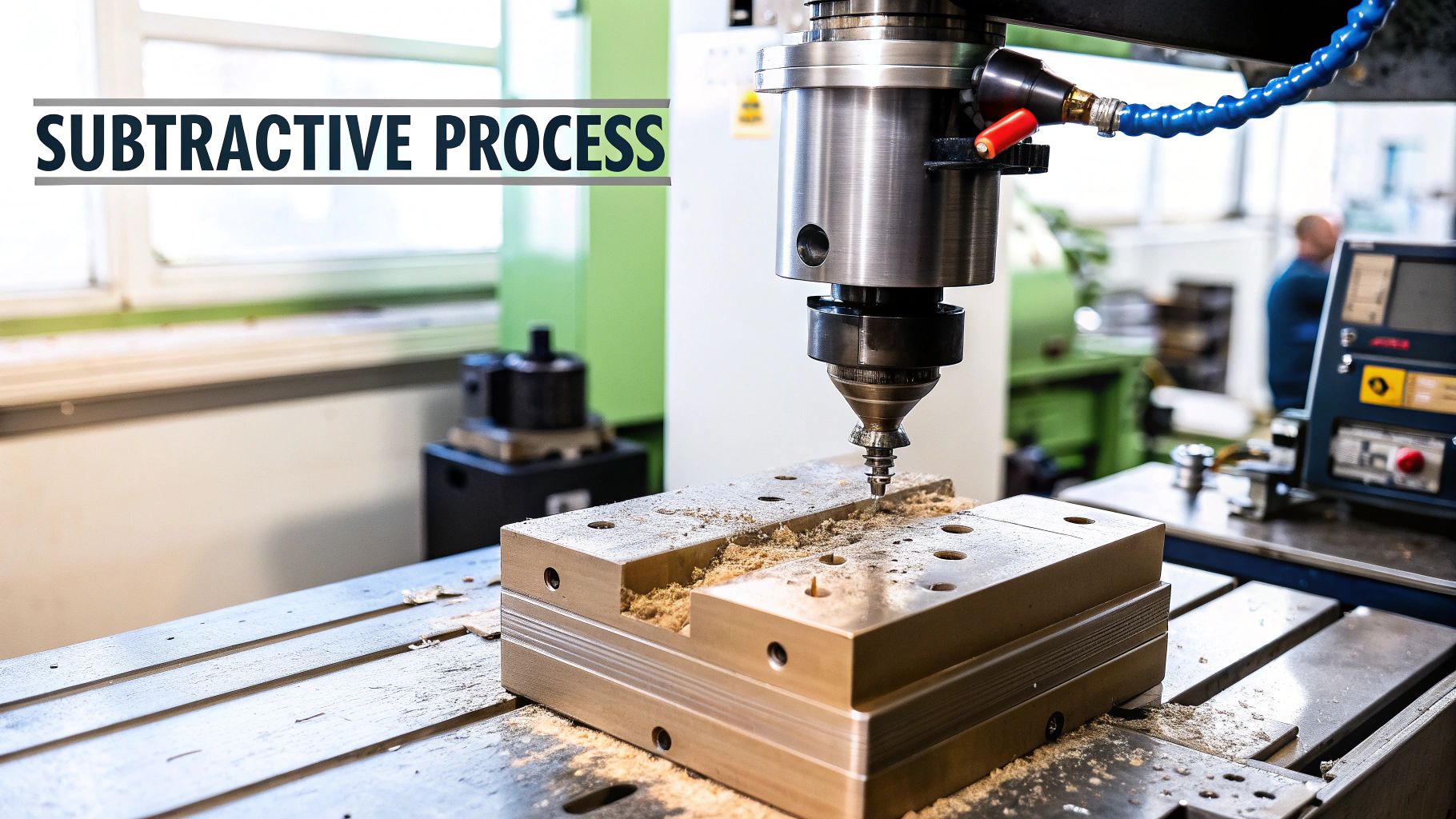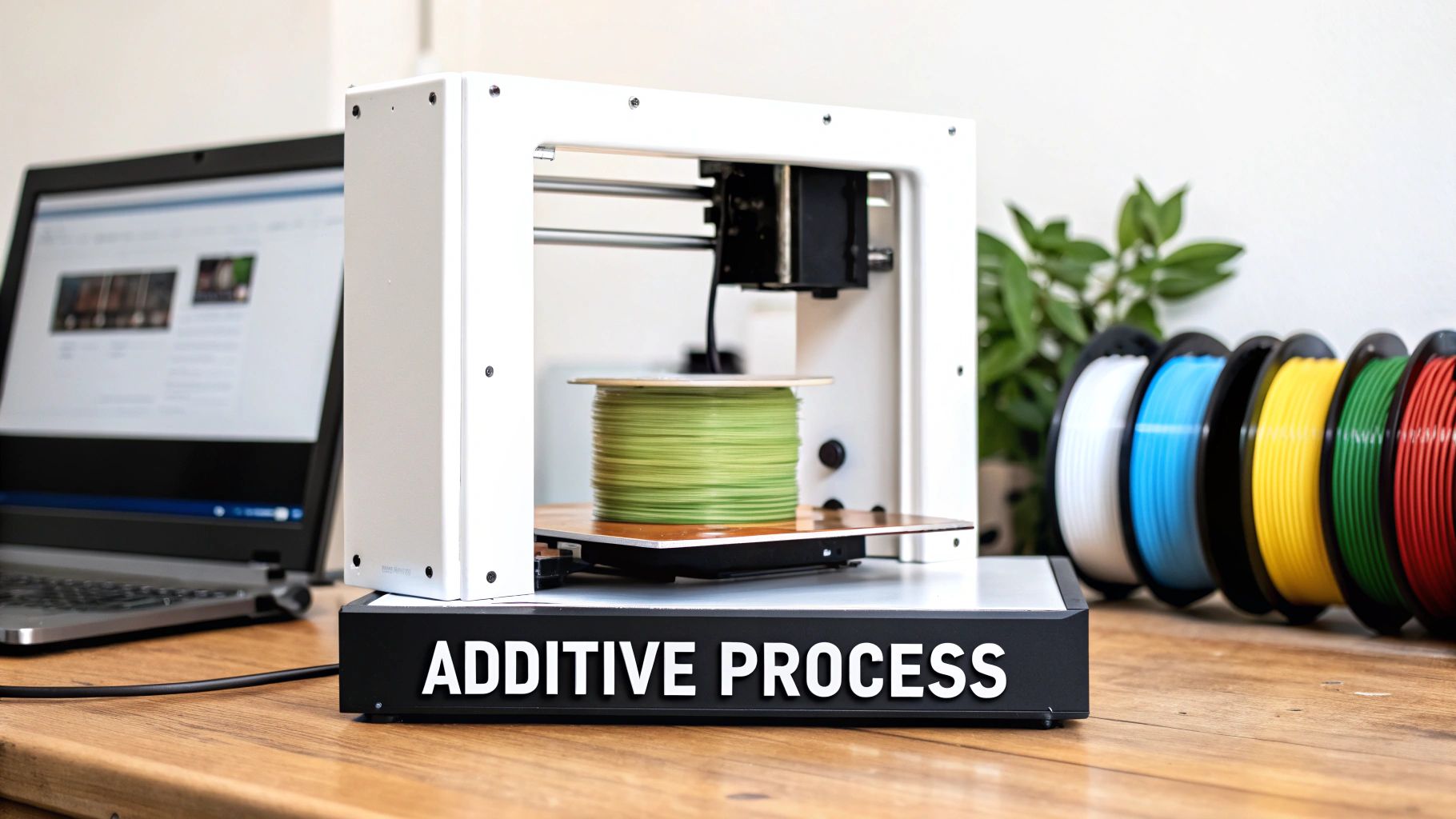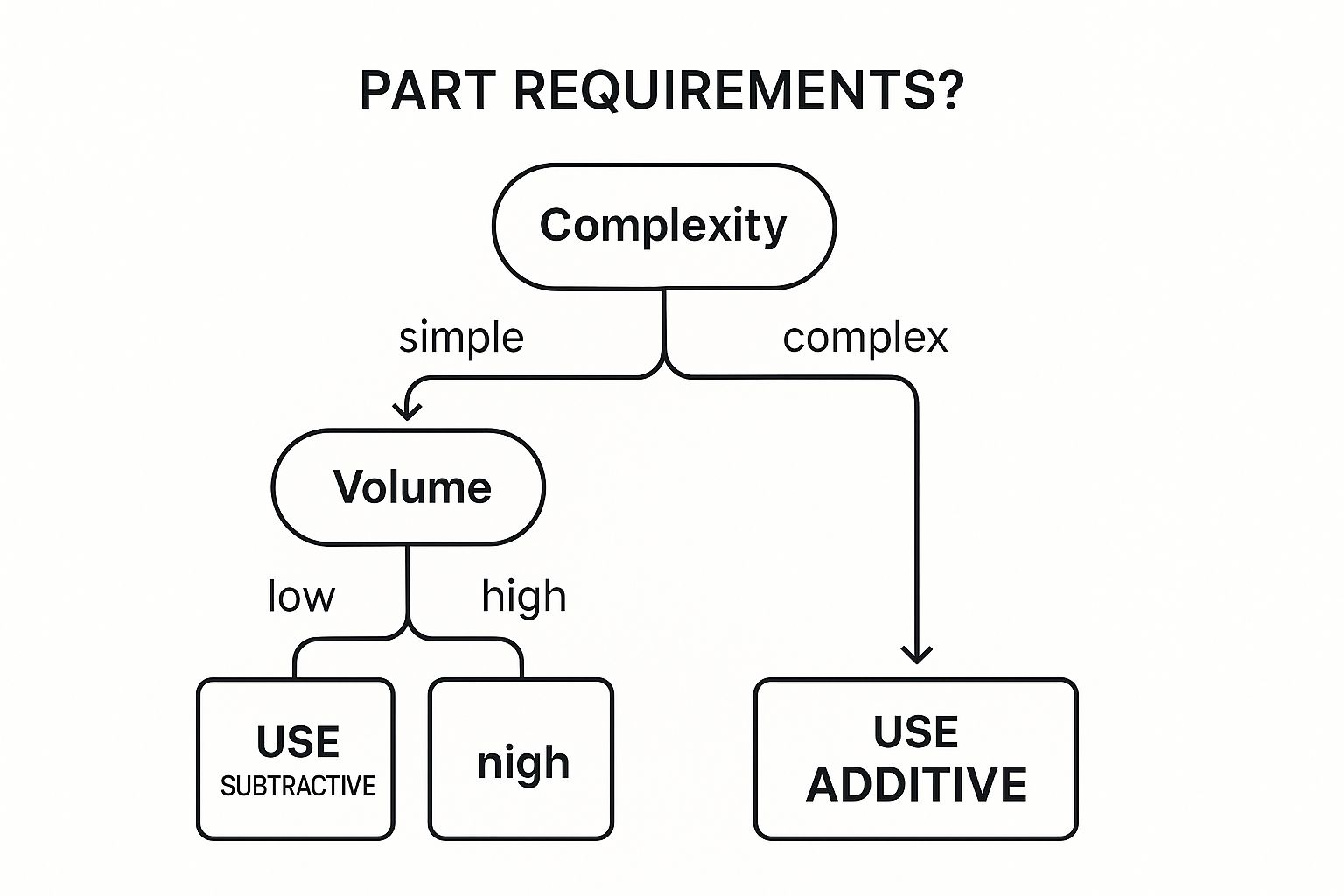Coming Soon: 3D Printing with AIS™ Antero® 800NA and 840CN03 Materials on the Stratasys F900Learn More

In the discourse of modern production, the distinction between subtractive manufacturing vs. additive manufacturing is fundamental. Subtractive methodologies operate by systematically removing material from a solid workpiece to achieve a final geometry. In contrast, additive processes construct objects layer-by-layer from raw material. An effective analogy is the subtractive process of a sculptor carving marble, versus the additive process of constructing a statue from the ground up, layer by layer.
At its essence, manufacturing is the transformation of raw materials into functional components. The two prevailing philosophies governing this transformation are subtractive and additive manufacturing, each possessing a distinct history, operational approach, and optimal application range. A comprehensive understanding of these foundational differences is critical for any engineer or designer tasked with selecting the most appropriate production method.
Subtractive manufacturing represents the traditional, time-tested pillar of industrial production. The process commences with a solid block of material—termed a workpiece or blank—from which excess material is removed via cutting, grinding, or drilling until only the desired part remains. Processes such as CNC milling and lathe turning are prime examples of subtractive manufacturing in practice.
Conversely, additive manufacturing, widely known as 3D printing, inverts this paradigm. Rather than removing material, it adds it with high precision in successive layers, guided directly by a digital design file. For a deeper analysis of its principles, refer to our guide on additive manufacturing. This methodology enables the creation of components with exceptionally complex geometries or internal channels that are unattainable through conventional machining.
The decision between these methods is not a question of inherent superiority, but of strategic alignment with project requirements. Subtractive manufacturing excels in applications requiring high strength, precision, and volume production. Additive manufacturing offers unparalleled design freedom and rapid fabrication for custom components and complex prototypes.
To delineate the key distinctions, the following table compares the primary attributes of these two manufacturing methodologies. It provides a concise overview of their fundamental operational differences.
AttributeSubtractive Manufacturing (e.g., CNC)Additive Manufacturing (e.g., 3D Printing)Core PrincipleMaterial is removed from a solid block.Material is added layer by layer.Material WasteHigher, as excess material is cut away.Minimal, as only necessary material is used.Geometric ComplexityLimited by tool access and part rigidity.Nearly unlimited, ideal for internal features.Best Use CaseHigh-volume production, high-strength parts.Prototyping, custom parts, complex designs.
This high-level comparison serves as an excellent starting point, but the nuances are what inform critical manufacturing decisions.
One of the most significant differentiators lies in their historical development and precision capabilities. Subtractive methods, forming the bedrock of industry since the Industrial Revolution, have been refined over decades to achieve exceptionally tight tolerances, often as fine as 0.025 mm. This level of precision is non-negotiable for mission-critical aerospace and automotive components where failure is not an option.
In contrast, even advanced additive processes typically achieve tolerances around 0.1 mm. While not as stringent as CNC machining, this level of accuracy is more than sufficient for rapid prototyping and producing parts where geometric freedom is valued over extreme dimensional precision.

The choice between subtractive and additive manufacturing dictates more than just the fabrication machinery; it defines the entire production workflow. This journey, from digital concept to physical component, differs significantly for each method. Understanding these workflows is essential for accurately forecasting project timelines, labor requirements, and overall operational efficiency.
Both pathways originate with a digital design file but diverge immediately based on their distinct Design for Manufacturability (DFM) principles.
With subtractive manufacturing, the design must accommodate the physical constraints of a cutting tool. This necessitates consideration of tool accessibility to all surfaces. Deep, narrow pockets or intricate internal geometries are often infeasible. Furthermore, part rigidity is a critical factor, as thin walls may vibrate or deflect under the force of the cutting tool, compromising the final part.
Additive manufacturing, or 3D printing, operates under a different set of rules, known as Design for Additive Manufacturing (DFAM). Key considerations include the strategic placement of support structures and part orientation. An optimized design minimizes the need for supports, which introduce significant time and cost to the post-processing stage. The part's orientation on the build plate is also critical for achieving optimal strength and surface quality.
Once the design is finalized, it must be translated into a set of machine-executable instructions. This is where the two workflows diverge most significantly.
With machine instructions prepared, the process moves to physical setup and fabrication. For a CNC machine, this involves securing the workpiece, loading the appropriate cutting tools, and establishing a precise reference point ("zero"). This meticulous and time-consuming task requires a trained operator.
Setting up a 3D printer is generally more straightforward, often involving little more than loading a spool of filament or replenishing a powder bed and ensuring the build plate is level. However, the labor in additive manufacturing is frequently back-loaded to the post-processing stage.
Post-processing is a critical factor that can negate the initial speed advantage of additive manufacturing. While a part may print in hours, the subsequent removal of supports, surface finishing, curing, or heat treatment can add significant time and labor, sometimes exceeding the entire machining time for a subtractive part.
For instance, a complex metal 3D-printed component may require hours of careful work to remove sintered supports, followed by additional machining to achieve a critical surface finish. A CNC-machined part, in contrast, often emerges from the machine with a finished surface, requiring minimal deburring.
This workflow reality demonstrates how the true https://www.americanadditive.com/post/transforming-manufacturing-the-impact-of-3d-printing-on-production-and-supply-chain is heavily influenced by post-build operations. True efficiency requires optimizing the entire process, including final steps like automation in packaging.

Beyond initial workflows, the subtractive vs. additive manufacturing debate centers on performance-critical attributes: precision, surface quality, and the structural integrity of the final part. These factors determine a component's suitability for applications ranging from simple prototypes to mission-critical assemblies in aerospace. The differences are fundamental, representing core trade-offs between the two manufacturing philosophies.
Subtractive manufacturing, by definition, creates parts from a solid, uniform block of material. This inherently sets a high benchmark for precision and surface finish. The process yields monolithic parts, meaning they are formed from a single, continuous piece. This results in isotropic mechanical properties—the part exhibits uniform strength regardless of the direction of applied force.
Additive manufacturing presents a different mechanical profile. It builds parts layer by layer, and this process can introduce microscopic variations at the interfaces between fused or bonded layers. This often leads to anisotropy, where a part’s strength and other mechanical properties are dependent on its build orientation. A component may be very strong along its X and Y axes but exhibit comparative weakness along the Z-axis, where interlayer adhesion is critical.
For any functional component requiring a precise fit within an assembly, dimensional accuracy—or tolerance—is paramount. This is an area where subtractive methods hold a clear and established advantage.
Modern CNC machines and other subtractive tools can reliably achieve extremely tight tolerances, often as precise as ±0.025 mm. This level of accuracy is essential for industries like aerospace, automotive, and medical devices, where components must meet stringent performance and safety standards.
Additive manufacturing technologies are continuously improving but generally operate with wider tolerances. Even high-end systems such as Selective Laser Melting (SLM) typically achieve tolerances around ±0.1 mm. While sufficient for many applications, particularly prototypes or parts with complex internal features, this may necessitate post-machining to meet the tight specifications required for functional interfaces.
A key takeaway for engineers is that subtractive manufacturing produces parts with superior, often finished-quality surfaces directly from the machine. Additive parts, due to their layered construction, frequently exhibit a "stair-stepping" effect and almost always require secondary finishing to achieve comparable smoothness.
The range of available materials represents another significant point of divergence. Subtractive manufacturing benefits from decades of material science, offering an extensive and well-characterized catalog of options.
This difference directly impacts the final mechanical properties of the part. A component machined from a solid block of forged aluminum retains the full, uniform strength of that raw material. In contrast, an additive part's integrity depends on the quality of the fusion between each individual layer.
These technological capabilities and precision metrics directly influence where each method excels. Subtractive processes like milling, turning, and EDM guarantee the high surface quality and repeatability needed for industrial production. Their compatibility with a vast range of materials makes them indispensable where durability is a top priority.
Additive manufacturing, conversely, excels at creating intricate geometries like internal channels or lattices that are impossible for subtractive methods. This flexibility, however, often comes at the cost of dimensional accuracy and surface finish, making post-processing a common requirement. To see how these different attributes enable specialized manufacturing aids, one can explore the benefits of jigs and fixtures in 3D printing. The emergence of hybrid systems, which combine additive for complexity and subtractive for precision finishing, effectively leverages the strengths of both worlds.
When comparing subtractive manufacturing vs. additive manufacturing, focusing solely on the per-part price provides an incomplete economic picture. A comprehensive analysis requires an examination of the total cost of production, which encompasses initial equipment investment, material expenses, labor, tooling, and operational overhead.
The upfront capital for equipment can vary dramatically. A high-precision 5-axis CNC machine can represent a major investment, often exceeding the cost of many industrial-grade 3D printers. However, this initial expenditure is only the first part of the financial equation.
A primary cost driver in subtractive manufacturing is material waste. The process fundamentally involves machining a final part from a larger, more expensive block of material. For complex geometries, it is not uncommon for 50% to 90% of the initial workpiece to become scrap. This waste, known as swarf, must be managed and represents a significant material cost, particularly when working with high-value alloys.
Additive manufacturing, conversely, is highly material-efficient. Because parts are built layer-by-layer, it consumes only the material required for the part itself and its support structures. This reduces the average scrap rate to approximately 5%, drastically cutting material costs and waste. This efficiency is a core reason it is viewed as a more sustainable alternative, a topic explored in our guide on the sustainability and green aspects of 3D printing.
The economic equation shifts dramatically when factoring in tooling. Subtractive manufacturing relies on an inventory of cutting tools, drills, and end mills that wear and require regular replacement. For additive manufacturing, physical tooling is virtually non-existent, eliminating an entire category of operational expense.
The most critical factor in the cost debate is almost always production volume. Additive manufacturing’s lack of tooling and minimal setup time makes it highly cost-effective for one-off prototypes and small production runs. A single, highly complex part can be printed without the substantial setup costs that would make a lone CNC-machined part prohibitively expensive.
However, as production volume increases, the economic balance shifts. The raw speed and automation of CNC machining create powerful economies of scale. Once a subtractive process is optimized, it can produce thousands of identical parts with a speed and repeatability that 3D printing cannot match, causing the per-part cost to plummet. This establishes a "crossover point" where, for larger batches, subtractive manufacturing becomes the clear economic choice.
These economic realities are reflected in their global market adoption. The additive manufacturing market, valued at approximately $15 billion in 2023, is projected to grow by 20-25% annually, driven by its dominance in aerospace, medical implants, and custom components. In contrast, the CNC machine market alone surpassed $70 billion in 2023, cementing subtractive manufacturing's role as the foundation of mass production. These figures indicate that the two methods are often complementary rather than competitive, with manufacturers increasingly using hybrid approaches to leverage the best of both worlds.

The theoretical debate over subtractive vs. additive manufacturing becomes significantly clearer when examining their practical applications on the factory floor. Leading industries select a method based on tangible outcomes like precision, strength, complexity, and speed. These real-world examples provide a concrete context for how each technology delivers value in specific applications.
Subtractive manufacturing remains the undisputed standard where strength and precision are non-negotiable. Its ability to work with an extensive catalog of proven materials makes it essential for components subjected to extreme stress that must perform reliably over long service lives.
Conversely, additive manufacturing has created new possibilities in fields previously constrained by traditional DFM (Design for Manufacturing) rules. It excels where the objectives are mass customization, geometric freedom, and weight reduction, enabling the production of parts that were once impossible.
Subtractive processes are the foundation of industries that form the backbone of modern engineering. The components they produce are often the most critical—those that must withstand immense mechanical loads and meet stringent dimensional specifications.
Additive manufacturing is no longer confined to prototyping; it is a full-scale production method creating the next generation of components. Its impact is most evident in sectors where part consolidation and intricate designs provide a distinct competitive advantage.
The true power of additive manufacturing is its ability to create parts designed for optimal function, not merely for ease of manufacturing. This allows for topology-optimized, lightweight structures and custom-fit medical devices that fundamentally improve performance.
The medical field is a significant area of growth. 3D printing is used to create patient-specific surgical guides and custom orthopedic implants. For example, a hip replacement can be perfectly tailored to an individual's unique anatomy, leading to improved comfort and faster recovery times. In aerospace, it is used to produce lightweight satellite brackets with complex internal lattices, reducing launch costs without compromising strength. For a deeper analysis, you can explore the revolutionary impact of additive manufacturing on modern industries.
The most forward-thinking engineers recognize that the optimal solution is often not an "either/or" choice. Hybrid manufacturing leverages the strengths of both processes to create components superior to what either method could achieve alone.
A common hybrid workflow begins with additive manufacturing to build a near-net shape part with complex internal features, such as conformal cooling channels inside an injection mold. This 3D-printed preform is then transferred to a CNC machine for a final finishing pass. The machining step creates the critical, high-tolerance surfaces and smooth finish that the additive process cannot deliver on its own.
This symbiotic approach yields a final part with both internal complexity and external precision, representing a perfect example of how these two technologies are often more complementary than competitive.
When evaluating options between subtractive and additive manufacturing, the optimal decision is reached not through a generic comparison but by asking targeted questions about specific project requirements. This approach moves beyond industry trends to identify the most practical and cost-effective solution for a given application.
This diagnostic process helps clarify the best path forward. By evaluating a part against critical variables—geometric complexity, production volume, and mechanical performance—the appropriate methodology typically becomes apparent. Each manufacturing philosophy excels under different conditions.
This simple framework can guide you toward the best-fit technology. By systematically addressing these questions, you can make an informed selection. In some cases, the answer may be a hybrid approach that utilizes both.
This decision tree provides a visual representation of how complexity and volume interact to guide technology selection.

As the infographic illustrates, the decision involves a straightforward trade-off. High-volume, low-complexity parts are the domain of subtractive machining. Low-volume, high-complexity parts are where additive manufacturing provides the most value.
Ultimately, the most effective strategy maps project requirements directly to technological strengths. Recommending additive manufacturing for a low-volume, high-complexity aerospace bracket is as sound as recommending subtractive manufacturing for 10,000 high-precision automotive components.
By systematically considering these factors—complexity, volume, and performance—you can move beyond a surface-level debate. This structured approach empowers you to make a confident, informed decision that is genuinely tailored to the demands of your part, ensuring the best possible outcome for your project.
When evaluating subtractive vs. additive manufacturing, several practical questions frequently arise. Addressing these common inquiries from our engineers can provide clarity and guide your decision-making process.
No, it is highly unlikely that one will ever completely replace the other. Instead, the trend in advanced manufacturing is toward a complementary relationship where these two technologies work in tandem.
Subtractive manufacturing remains the unparalleled choice for high-volume production runs and for applications demanding exceptional material strength and the tightest possible tolerances. For many industries, these qualities are non-negotiable.
Additive manufacturing excels where subtractive methods face limitations—namely, in creating highly complex internal geometries, enabling mass customization, and fabricating one-off prototypes with unprecedented speed. The future of manufacturing is not about choosing one over the other, but about knowing when to leverage each process for its unique strengths, sometimes within the production of a single part.
The question of sustainability is nuanced, with trade-offs on both sides. The "greener" method depends on whether the primary concern is material waste or energy consumption.
While additive manufacturing generates far less waste, the high energy demands of processes like laser powder bed fusion can sometimes offset its material savings. A comprehensive sustainability analysis must consider the entire product lifecycle, from raw material sourcing and energy consumption to logistics and end-of-life disposal.
Hybrid manufacturing is an advanced approach that integrates additive and subtractive processes, often within a single machine or a seamless workflow. It harnesses the strengths of both technologies to produce components that would be difficult or impossible to create with a single method.
The core concept is to use additive manufacturing for what it does best—such as building parts with intricate internal features or creating a near-net shape—and then use subtractive processes for precision finishing. This allows for the achievement of perfect surface finishes or interfaces with exceptionally tight tolerances.
Common use cases for hybrid manufacturing include:
This symbiotic relationship represents the pinnacle of modern manufacturing, offering unparalleled design freedom without sacrificing mission-critical precision.
Ready to explore how additive manufacturing can streamline your production and solve complex engineering challenges? At American Additive Manufacturing LLC, we specialize in transforming your designs into high-performance components. Explore our advanced manufacturing services and begin your project today.